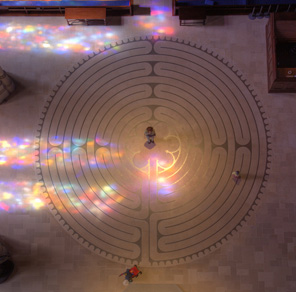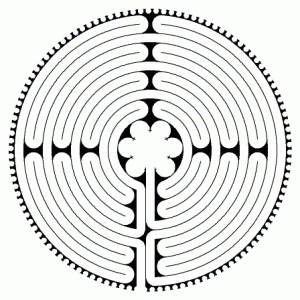Reverend Lauren Artress is an inspiring Canon at Grace Cathedral in San Francisco, and a spiritual pioneer in the Labyrinth Movement. She has written many books on the labyrinth and holds workshops around the world. Lauren’s labyrinth-based nonprofit, Veriditas, has the mission to “pepper the world with labyrinths.”
Greer: Let’s start very simply; what is a labyrinth?
Lauren: A labyrinth is a design, oriented flat on the floor, that is usually a 40-foot circular pattern. There is one path that leads from the outer edge in a very circuitous way into a stabilized center. And the walker, the person walking the labyrinth, walks the path—simply that.
A labyrinth is not a maze; a maze is a cognitive puzzle designed for you to lose your way. A labyrinth is a path that you follow to find your way. They are diametrically opposed. There is one theory that when we became so oriented to linear thinking, mazes were a way to destroy labyrinths. All you have to do is remove one path and make it into a puzzle so that people lose their way. Mazes are about 600 years old, whereas labyrinths are about 4-5,ooo years old.
Greer: What is the process of walking a labyrinth like?
Lauren: Usually we think of the labyrinth as having three different stages. Sometimes people describe it as four — I often describe it as the “Three R’s:” releasing, receiving, returning. If you are dealing with four stages, the first is remembering – remembering that you are blessed, that you are loved. Often as people wait to enter a labyrinth they do some preparation, which is where remembering can be very helpful.
Once you walk in and cross the threshold into the labyrinth, you find your natural pace. This is an important thing to do when you are walking that first part of the labyrinth. Find your natural pace. It will change throughout the walk.
Often people start a little quicker, then slow down once they find the pace their body wants to go, not the pace their mind thinks they should go. Then you can more easily enter your own flow and there is usually a releasing process that happens; that would be, the first “R.”
There is a deeper place that we live if we allow ourselves to come there.
You are letting go; you are shedding…letting go of everyday thoughts, and allowing yourself to come home to yourself. There is a deeper place that we live if we allow ourselves to come there.
The second stage starts as you arrive at the center. You have released; you have shed; you have emptied; you have made space in your being to receive. That’s the second “R,” receiving. At that point, you can sit, or stand, and stay as long as you want in the center. Often there are many people in the center.
Then, when you are ready, you walk the return path back out. And that’s the third “R,” returning. Often people reclaim something, or they come to a resolution about how they want to live their lives.
People might just use that third stage for reflection, as they walk back out the same path. There is an integration to it, a sense of strengthening as you walk back out of a labyrinth.
This is a thumbnail sketch. These stages can happen at anywhere in a labyrinth, you can receive anywhere; you can release anywhere and often — especially if people are dealing with grief, a time of tears — you really let yourself feel what you need to feel. This is a time and place to do just that.
Greer: Can you tell me a bit more about how walking a labyrinth can help with the grieving process?
Lauren: The mind is focused on following the meditative pattern of a labyrinth during the walk. This allows other parts of our being to open up — the imagination and the intuitive sense of our nature. With grief specifically — the way I understand and experience my own grief — it is like a well that fills up. When it fills, then you need to release.
The labyrinth is like coming home to yourself. You sink into yourself, and often when the well is filled inside, then the labyrinth becomes a safe place to feel those feelings. People weep and cry in the labyrinth, and we just encourage people to stay with it because the well will get dry again. Then people go on about their lives. Then the well fills up again, and that is a great time to go back to a labyrinth.
Each labyrinth walk is different, even if you walk it a second time right away. It is that sense that you can’t step into the same river twice. But that is different with someone who is grieving, because there is a deep river there, and you are stepping back into that same river.
So a person who is grieving might want to walk two or three times until they feel that the well has been dried and drained. It could be one or two walks, or it could be staying and not rushing when you come to the center.
Some people in grief use it regularly. They might make a practice of it for themselves. They might go every Monday morning or every Friday after their work week. Moving it into a regular schedule is really helpful.
One of the major uses of a labyrinth, besides active grieving, is for family members when their loved one is in a hospital or in hospice. We have trained facilitators for just that. A family might walk the labyrinth together as they tend to their loved one as that person makes a transition. I don’t mean at the moment of, but days before, as family gathers at the bedside.
Of course, the main metaphor is that we are all walking this path together. We are in different stages, some of us are ending the journey, some of us beginning, most of us are in the middle…on the way into the middle.
Walking the labyrinth is a great nonverbal activity. It goes beyond words. Words are where we get in trouble. But when we do an activity together that is reflective, that is meditative, you are alone together in that process. It can be very helpful to build bonds between people, built in a meditative knowingness. Of course, the main metaphor is that we are all walking this path together. We are in different stages, some of us are ending the journey, some of us beginning, most of us are in the middle…on the way into the middle.
Greer: Can people benefit from a onetime walk of the labyrinth?
Lauren: Absolutely. Oftentimes, when a person comes to a labyrinth for the first time, they are so ready for the labyrinth that it is an important experience for them — and then they return because it becomes such an impactful experience.
The important thing is to not set up expectations: “I had a really significant experience the first time. I am going to walk it again and have another really important experience.” That might not be what is so. Especially the second time. The second time might be a way of integrating or furthering the first labyrinth walk, but it will be different from the first time.
It’s interesting because you develop a relationship with a labyrinth; they become old friends. And I encourage people to find their own style. You need to find the style that works for you.
The two major styles are the Chartres, eleven-circuit medieval style, which is replicated from Chartres Cathedral in France, and the classical seven-circuit labyrinth. The Chartres style has 28 180-degree turns, so you are spiraling into the center in a clockwise way, turning back on yourself 28 times. The classical style does not have the 180-degree turns. They have maybe four of them at the outer edge of the turn, and the turns aren’t as tight.
This makes a difference…we don’t actually know why, but the classical labyrinth is more extraverted. You come out in a more extraverted way, ready to talk. But in the Chartres style, you come out in a more meditative mindset.
Greer: Is there any particular etiquette in a labyrinth?
Lauren: Not really. It is really important that people tailor make the labyrinth to be their own tool.
Sometimes when I talk to people who have a meditative practice that has fallen away, one of the essential ingredients of it falling away is that they are trying to do someone else’s practice. When you approach a labyrinth, you might not even know why you are doing it. But you might just want to just walk it. Sometimes people have a sense of why they are walking it, but not always.
If you are short on time, maybe you just walk into the center. We do encourage the return path if people have time, but people should tailor make it for their own walking — tailor make it for what they need rather than following strict rules around it.
Lauren’s Three Tips for Walking a Labyrinth:
1. Find and follow your natural pace. Let people move around you and move around them. The labyrinth is a two-way street. When you meet on the path, do whatever feels natural. If you want to stay in a meditative space, keep your eyes down. Or, make eye contact and smile if you feel inclined to do so. You can also meditate on the people around you if you are feeling overwhelmed by a crowd.
2. Make sure you don’t walk in with expectations; expectations take you away not toward your experience. Experience your own experience as it unfolds.
3. If you want to use a labyrinth as part of a memorial service, ceremony or ritual, hire a facilitator who is trained in holding sacred space and who can be sensitive to the needs of a larger group as a whole.
Greer: Can you tell me about how you got involved in labyrinths?
Lauren: I came across the labyrinth through Jean Houston. It was 1991, and I was thinking at that time that I needed to leave Grace Cathedral. I was the canon pastor and we had many people die of AIDS. In 1989, we had 92 people in the congregation die. People come to the cathedral if they don’t have a church but they are in trouble — they come for solace. So the whole AIDS epidemic was part of my discovery of the labyrinth, as I realized we needed a nonverbal tool that would provide solace to people.
Greer: I keep thinking about how a labyrinth integrates public and private space. Labyrinths are in public places, but people have these intense private experiences in it. Potentially, they promote community and finding solace in community.
Lauren: That’s a good point. There is a dance between public and private. That is one of the wonderful things about the labyrinth. A lot of people walk it alone. Once you step across the threshold, the labyrinth has a really clear container feeling to it. People feel very safe in the labyrinth. And again, we train facilitators to be present at the labyrinth, how to hold that space, which is a spiritual practice in itself.
Also the path is intense. This is why the Chartres style is my heartsong. It pulls people deeply into the process, because the path, I wouldn’t say is complicated, but it is certainly circuitous. The mind is doing the activity of focusing on the labyrinth. The rest of our deep intuitive nature is allowed to come forward because the mind is occupied in a very solid way, which can be helpful if we are storing a lot of emotion, like grief.
It is not unusual to see people crying when they are walking the labyrinth, even though it might be in a very public space like Grace Cathedral. The threshold has a real container feeling, which is really an important element. And it is an important element for creating community as well.
The labyrinth is excellent for use in hospices and hospitals for the staff, volunteers and employees. We have trained many people in hospice, and they are reporting that the staff is using it, because there is a lot of burnout in hospice work, if you are struggling with how to continually hold the process of death.
Greer: So, allowing the mind to focus on the labyrinth pattern is a way to access the spirit…
Lauren: Yes, especially for Westerners, and especially now, with how rapid our society is and how quick everything needs to be and how loud the external world is. We don’t have any respect for the interior world. There is very little respect for it. So stepping into the interior world by stepping into a large outer world pattern gives the mind something to do, which is a perfect practice for Westerners.
Greer: Thank you, Lauren, for such an inspiring conversation!
Lauren: Thank you.
To read Part One of this interview, click here!

 How Can a Labyrinth Help in the Grieving Process? An Interview with Lauren Artress
How Can a Labyrinth Help in the Grieving Process? An Interview with Lauren Artress










 Recovering Cremation Remains After the Los Angeles Fires
Recovering Cremation Remains After the Los Angeles Fires
 “As Tears Go By” by Marianne Faithfull
“As Tears Go By” by Marianne Faithfull
 “The Sea” by John Banville
“The Sea” by John Banville














